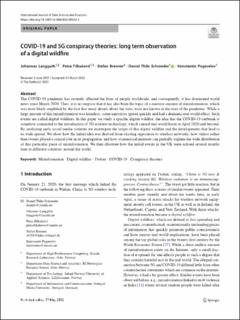| dc.contributor.author | Langguth, Johannes | |
| dc.contributor.author | Filkukova, Petra | |
| dc.contributor.author | Brenner, Stefan | |
| dc.contributor.author | Schroeder, Daniel Thilo | |
| dc.contributor.author | Pogorelov, Konstantin | |
| dc.date.accessioned | 2022-08-02T13:29:26Z | |
| dc.date.available | 2022-08-02T13:29:26Z | |
| dc.date.created | 2022-07-19T09:51:51Z | |
| dc.date.issued | 2022 | |
| dc.identifier.citation | International Journal of Data Science and Analytics (JDSA). 2022, Online First May 27. 2022, 1329 | en_US |
| dc.identifier.issn | 2364-415X | |
| dc.identifier.uri | https://hdl.handle.net/11250/3009813 | |
| dc.description.abstract | The COVID-19 pandemic has severely affected the lives of people worldwide, and consequently, it has dominated world news since March 2020. Thus, it is no surprise that it has also been the topic of a massive amount of misinformation, which was most likely amplified by the fact that many details about the virus were not known at the start of the pandemic. While a large amount of this misinformation was harmless, some narratives spread quickly and had a dramatic real-world effect. Such events are called digital wildfires. In this paper we study a specific digital wildfire: the idea that the COVID-19 outbreak is somehow connected to the introduction of 5G wireless technology, which caused real-world harm in April 2020 and beyond. By analyzing early social media contents we investigate the origin of this digital wildfire and the developments that lead to its wide spread. We show how the initial idea was derived from existing opposition to wireless networks, how videos rather than tweets played a crucial role in its propagation, and how commercial interests can partially explain the wide distribution of this particular piece of misinformation. We then illustrate how the initial events in the UK were echoed several months later in different countries around the world. | en_US |
| dc.language.iso | eng | en_US |
| dc.publisher | Springer | en_US |
| dc.rights | Navngivelse 4.0 Internasjonal | * |
| dc.rights.uri | http://creativecommons.org/licenses/by/4.0/deed.no | * |
| dc.subject | Misinformation | en_US |
| dc.subject | Digital wildfire | en_US |
| dc.subject | Twitter | en_US |
| dc.subject | COVID-19 | en_US |
| dc.subject | Conspiracy theories | en_US |
| dc.title | COVID-19 and 5G conspiracy theories: long term observation of a digital wildfire | en_US |
| dc.title.alternative | COVID-19 and 5G conspiracy theories: long term observation of a digital wildfire | en_US |
| dc.type | Peer reviewed | en_US |
| dc.type | Journal article | en_US |
| dc.description.version | publishedVersion | en_US |
| dc.rights.holder | The Authors | en_US |
| dc.source.pagenumber | 18 | en_US |
| dc.source.journal | International Journal of Data Science and Analytics (JDSA) | en_US |
| dc.identifier.doi | 10.1007/s41060-022-00322-3 | |
| dc.identifier.cristin | 2038737 | |
| cristin.ispublished | true | |
| cristin.fulltext | original | |
| cristin.qualitycode | 1 | |

